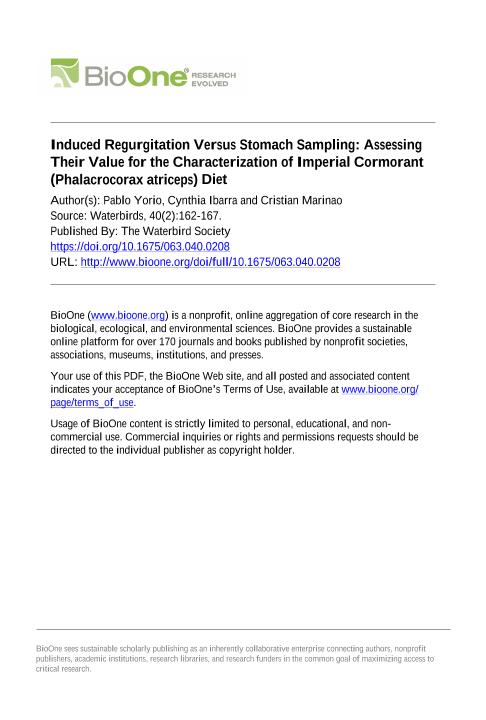Artículo
Induced Regurgitation Versus Stomach Sampling: Assessing Their Value for the Characterization of Imperial Cormorant (Phalacrocorax atriceps) Diet
Fecha de publicación:
06/2017
Editorial:
Waterbird Society
Revista:
Waterbirds
ISSN:
1524-4695
e-ISSN:
1938-5390
Idioma:
Inglés
Tipo de recurso:
Artículo publicado
Clasificación temática:
Resumen
Several studies have applied induced regurgitations to characterize the diet of cormorants, but none have presented quantitative information indicating complete stomach contents were obtained. Our goal was to test the value of induced regurgitations for the assessment and monitoring of Imperial Cormorant (Phalacrocorax atriceps) diet. Stomach samples were obtained from male and female breeding adults bringing food back to the colony during the chick rearing stage (n = 22) at Isla Arce, Argentina. Samples were obtained through induced regurgitation, and immediately afterward each individual was flushed with sea water. The diet of the Imperial Cormorant consisted of at least 23 prey taxa, mostly fish complemented by crustaceans, cephalopods and polychaetes. However, only Argentine anchovy (Engraulis anchoita) and rockcods (Patagonotothen spp.) showed a significant contribution by mass (70.7% and 25.3%, respectively). Analysis of similarity indicated that prey composition between samples obtained by induced regurgitation and those obtained by combining regurgitation followed by stomach flushing were similar in both the numerical frequency of all prey taxa recorded and the contribution by mass of the main prey. Our results show that induced regurgitation provides complete stomach contents, and thus validates the use of this technique for quantifying Imperial Cormorant diet composition.
Archivos asociados
Licencia
Identificadores
Colecciones
Articulos(CESIMAR)
Articulos de CENTRO PARA EL ESTUDIO DE SISTEMAS MARINOS
Articulos de CENTRO PARA EL ESTUDIO DE SISTEMAS MARINOS
Citación
Yorio, Pablo Martin; Ibarra, Cynthia; Marinao, Cristian Javier; Induced Regurgitation Versus Stomach Sampling: Assessing Their Value for the Characterization of Imperial Cormorant (Phalacrocorax atriceps) Diet; Waterbird Society; Waterbirds; 40; 2; 6-2017; 162-167
Compartir
Altmétricas




